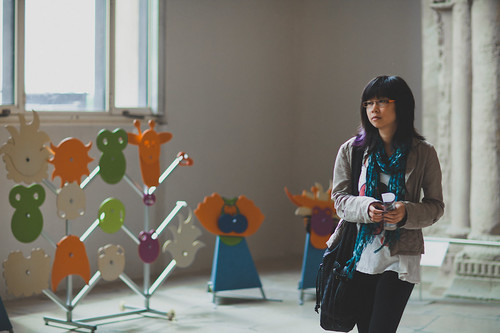 |
| Meet Shelly! Sketching in a Parisian rose garden. |
Tell us a little bit about yourself—school,
background, major, reasons for taking this trip, anything else interesting you
want to share.
My name is Shelly Leroux and I am a Fine Arts
student who works in many mediums, but my main focus is on conceptual work
dealing with social and environmental issues. I am super excited about being a
part of the Paris Fine Arts Field Trip because I am currently graduating from
Kwantlen University and thought a trip to Paris would be the best way to
celebrate my dedication to earning a degree. When I was a child, I lived in
Europe for four years with my family, and I had so many great memories and
experiences, so coming back to Europe was a really special opportunity. I am
mostly looking forward to attending Documenta because I have never been to an international
art celebration before, and I am extremely curious of how Canadian artists will
compare on an international level. I have been involved with the Surreyalists Collective for the last two years and I invite all of you to our ‘Altered’ Show which opens at 7pm, July 6, at Chapel Arts in Vancouver, BC.
 |
| Tiny storefronts with painted art works dot the side streets around Paris. |
What has met or exceeded your expectations
or surprised you about Paris so far?
There are many things that surprised me
about Paris. The first thing that surprised me would be the low cost of food
and alcohol. The first night we were here, our group purchased bottles of wine
that ranged from $1 -$6, which was a very pleasant surprise! The second
thing about Paris that I found surprising is the tiny storefronts that exist
along little winding roads. Some of us
discovered a little area with commercial art galleries that were all along a
small strip of shops that would be comparable to the Granville street shops,
only that they are smaller!
 |
| Shelly photographing art works at the Palais de Tokyo (Photo courtesy: Kyubo Yun-- spot him in the cubed mirror!) |
Give us some insight into your assigned art
work from the Muse d’ Orsay. After seeing the work in person, what struck you
most about it and/or how did the art work’s form, content, and context shift
for you when seeing it?
 |
| Edouard Manet, The Balcony (1868) |
The assigned painting I received was
Edouard Manet’s The Balcony (1868). This painting reflects the modernity and
changes happening to Parisians during this time. Each person is fashionably
modern and appears to be looking out and watching the spectacle of Paris. Even
the dog is so distracted by the commotion that he neglects his ball. Manet used
his friends (including Berthe Morisot) and fabricated a balcony scene using a
railing and shutters in his studio space. What I found significant in this
painting is that the male flaneur is holding his cigarette. This is essential
because Paris was experiencing a booming industry in cigarettes during this
time. My immediate response to seeing this painting in the Orsay Museum would
be that it is larger than I had imagined. This painting is on the right hand
side of the room, and it is situated in a way so that it looks centered in a
room full of Manet’s paintings. The Balcony is situated between two other Manet
paintings, Grosse Mer A Etretat is on the left side, and La Pie on the
right side. During my research of my assigned painting, I used Google Art to
ensure that I saw everything I needed to create my analysis. After seeing the
painting in life, I would declare that Google Art was incredibly accurate and
allowed me to spot every detail on the canvas, including the boy in the dark
apartment, and the details of the interior space that is not viewable in
textbooks.
Today’s activity was at the Palace of
Versailles. What were your impressions? What will you take away of the
experience? What, if any are the memorable moments for you?
 |
| The masses descend on Versailles Palace! |
 |
| Students Shannon, Kyubo and Rhea sketching and drawing a crowd in in the Mirror room at Versailles Palace |
Today’s activity was the Chateau de
Versailles. It was an overly embellished castle with every luxury imaginable.
It would reflect a present day Donald Trump home dashing with mirrors,
chandeliers, and lots of gold. The special
configuration of Versailles and the movement of the people through the palace
contributed to the creation of ‘tourist rage’. A social phenomenon that makes
tourists act aggressively. While our group waited in line another group merged
and declined to go to the back, which caused frenzy, a spectacle, and an
awkward wait to the entrance. This is something that is comparable to the
spectacle and the flaneur that French bourgeois experienced during their times
of leisure. During our long wait in an
insanely long and winding line-up, I imagined how the bourgeois would act while
waiting in line for the spectacle at the morgue, or wax museum. I wondered what
kinds of rages occur in a line-up full of various classes merging together,
standing closely, and occasionally bumping into one another.


























